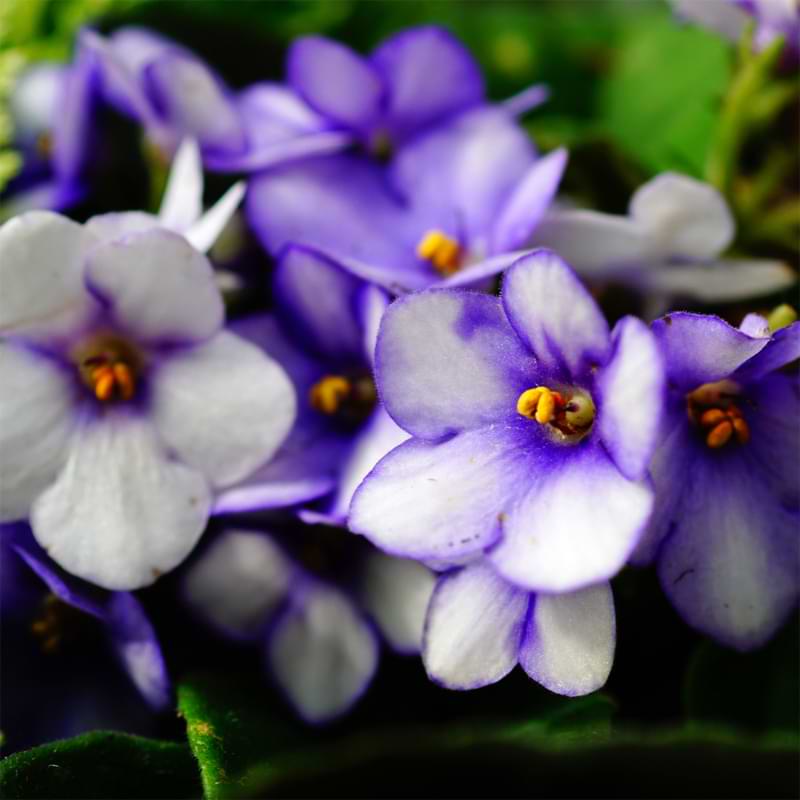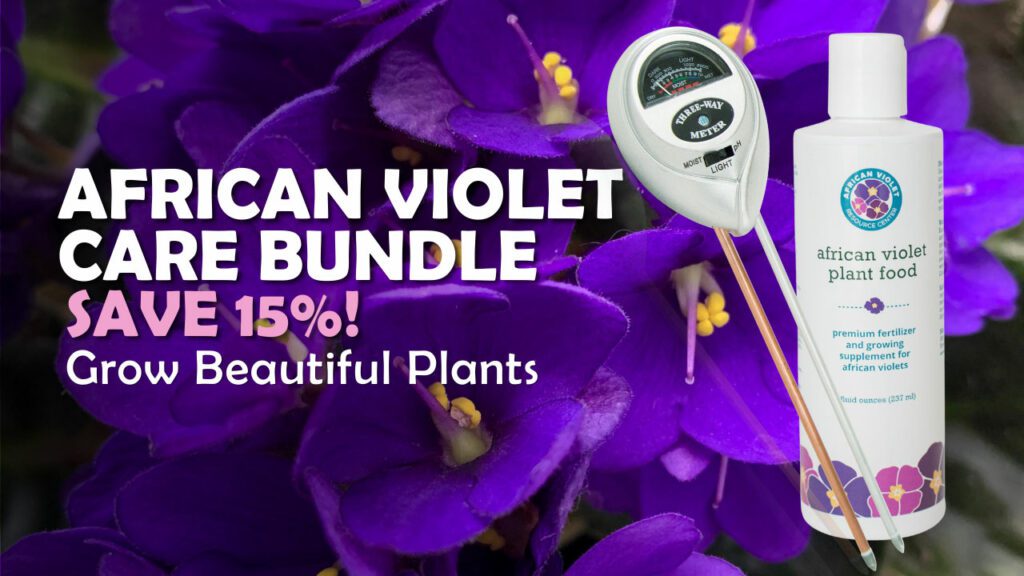As a native flower to the East African rainforests of Tanzania, it’s safe to say that these beautiful flowers love humidity. But just because African violets like humidity doesn’t mean they can’t thrive in drier environments.
Read on as we dive deep into the relationship between African Violets, their optimal growing environment, and how you can ensure your precious plant receives everything needed to thrive throughout the year.
How Much Humidity Do African Violets Need?
Optimal humidity levels should mimic their natural growing environment, which hovers between 70% to 80%. At these levels, the compact plants can really thrive, growing their signature fuzzy leaves and developing stunning blooms.
But, as a common indoor houseplant, maintaining that level of humidity isn’t always easy. The good news is that African violets have been known to adapt well to slightly lower humidity levels as long as they are consistent.
Many growers have found that humidity levels between 50% and 60% can still produce beautiful, healthy African violets. However, when humidity is at this range, you may notice other growth issues that can be easily managed with a few simple care techniques.
Symptoms of Low Humidity in African Violets
Slow Growth
The primary indicator of less-than-optimal humidity levels is slow or stunted growth. Healthy African Violets will grow quickly under ideal conditions, reaching full maturity from a cutting or seedling within 10 months. After starting a regular active growing cycle, they should produce healthy blooms every 6 to 8 weeks.
Furthermore, leaves should grow at a healthy rate, with new growth occurring from the center out, pushing old leaves down. If new growth isn’t happening as frequently as it was during propagation, or it seems to have slowed and is only showing dead or yellowing leaves with no new growth to push them off, this is a sign of low humidity levels.
Buds Failing To Open
Humidity is the key to healthy blooms, and without it, the African Violet’s transpiration rate will be too low to support new bud development. As a result, buds on the plant may fail to open and bloom, a disappointment for growers excited to make these beauties the centerpiece of their homes.
Furthermore, any open blooms may wilt or brown faster than usual without enough humidity. Be aware that this can also be caused by other environmental factors, such as overwatering or too much direct sunlight, so you may need to adjust more than the humidity to keep your blooms looking their best.
Leaves With Brown Edges
In their native habitat, African Violets grow low to the ground, under other tropical plants, allowing them to retain constant moisture from dripping rainwater. When that moisture and humidity are lacking, leaves will quickly brown at the edges and tips.
This phenomenon can look a lot like spent leaves and is something growers struggle with correctly identifying. However, a key indicator will be the browning of new growth in combination with slowed or stunted leaf development.
Dry and Shriveled Leaves
When humidity is too low, leaves will do more than just brown at the edges; they will also start shriveling or drying out. This symptom is commonly seen with too low humidity and too much dry air circulation from drafts, vents, or arid climates.
Unfortunately, once the whole leaf dries out and fades, there is no way to bring it back to life. The only course of action is to adjust humidity levels until new leaf growth occurs that is green and healthy.

Easy Ways To Increase Humidity
Humidifiers
Air humidifiers aren’t just great for people; they are an excellent option for houseplants. They come in all shapes and sizes, from small single-room options to larger whole-home humidifiers, but the key is to find one that works best for your growing space and budget.
When placing a humidifier, aim to put it about three to five feet away from your plants and not in the corner of a room. It is also wise to slowly increase the humidity in the room the plant is in so that it has time to adjust to the changes, avoiding plant shock that can cause foliar issues.
If your space is too small for a full-sized humidifier, or high humidity affects the health of other people in the home, look for options explicitly designed for houseplants. Many models are small enough to fit on a shelf near your plants, allowing for targeted humidity without causing issues for those living with you.
Humidity Trays
Humidity trays are a cost-effective and environmentally friendly way to increase humidity levels in your growing space. They consist of a tray filled with water, small stones or pebbles, and the plant pot placed on top.
As the water evaporates from the tray, it increases the humidity level around the plant. This method is perfect for those with limited space or budget who want to provide their African Violet with an environment closer to their native rainforest.
Misters & Spritzers
If you have the time to dedicate to frequent misting or spraying, then using a mister or plant spritzer can effectively raise humidity levels. These devices emit a fine mist of water, which the plant and surrounding air can quickly absorb.
The key to using this technique will be understanding how much to mist without causing soil conditions that lead to root rot, fungal growth, or bacterial issues. This often happens if you mist the foliage rather than the air around the plant or miss misting for a day or two and then compensate by overdoing it.
Mulching
Popular for outdoor plants, mulching also has benefits for indoor plants like African violets. By mulching the top layer of African Violet soil with materials like sphagnum moss, coconut coir, or compost, you can retain moisture in the soil and create a microclimate that increases humidity around the plant.
This method is most effective when combined with other humidity-increasing techniques and works best for those who prefer a more natural approach to plant care. Be aware that African Violets prefer slightly acid soil conditions, so the mulch you use should reflect this. It should also not be packed so densely that it reduces the drainage of potting soil the plant is in.
Terrariums
Stylish, ornamental, and effective terrariums are a great way to increase your plants’ humidity levels and create an attractive display piece in your home. Terrariums are essentially miniature greenhouses that trap moisture and heat, providing the perfect environment for African Violets to thrive.
You can purchase pre-made terrariums or create your own using a glass container and soil suitable for African Violets. The key to success with this method is to ensure proper ventilation by removing the lid or opening it periodically to let fresh air in.
Group Plants Together
Plants emit moisture through their leaves in a process called transpiration. Placing multiple plants together can create a microclimate of increased humidity that benefits all the plants in the group. This method is perfect for smaller spaces and requires minimal effort or cost.
However, be aware that this technique may not work well for African Violets if the other plants need significantly different humidity levels. In such cases, it is best to group plants with similar needs together. If you don’t have other houseplants like pothos or ferns to group with, consider propagating more African Violets so they can all benefit from each other’s transpiration.
Best Place To Put An African Violet for Optimal Humidity
While any place in a home or garden with bright, indirect sunlight is ideal for African Violets, certain areas may be more suitable for maintaining optimal humidity levels.
Bathrooms and kitchens are often the most humid areas of a home due to the regular use of hot water and steam from cooking. These spaces can be great locations for African Violets if they receive enough natural light.
Near fish tanks containing 50 gallons or more is also a good spot. Tanks this size can evaporate up to a gallon of water per day, providing ample humidity for your plants. Just make sure to keep them away from any harsh tank fertilizers that may harm the plant.
You can also consider hanging them up higher in a room. In thermodynamics, heat rises, so elevated areas like shelves or hooks near the ceiling are typically warmer and more humid. Just make sure not to place them too close to a light source, as this can cause leaf burn.
Placing African Violets outdoors under a porch or near other plants that provide shade can also help increase humidity levels. Just be sure to keep an eye on the amount of direct sunlight they receive, as too much can damage their delicate leaves.
Wherever you decide to put an African Violet, just be sure it isn’t near an air conditioner, vent, or drafty window. These spaces can quickly dry out the plant’s soil, create an environment with too low humidity, and ultimately harm the plant.
African Violet FAQ
1. Is watering the same as humidity?
No, watering and humidity are not the same. Watering refers to providing your plant with enough water for proper growth and development, while humidity refers to the amount of moisture in the air surrounding the plant. While watering is vital for keeping your African Violet hydrated, increasing humidity levels can also benefit its overall health.
2. Do African Violets like humidity all the time?
Yes, African Violets prefer a consistent level of humidity around them as this mimics their natural growing environment and triggers the blooming process. However, excess humidity can lead to issues such as root rot and fungal growth, so monitoring and adjusting humidity levels is essential to healthy plant growth and flowering.
3. Can I mist African Violet leaves?
No, misting African Violet leaves causes water to collect in the crown of the plant, which can lead to rot and other issues. It is better to mist the air surrounding the plant and wipe off any moisture that may have landed on the leaves using a 100% cotton cloth.
4. When is the best time to increase humidity for African Violets?
The best time to increase humidity levels for African Violets is during their active growing season, which typically lasts from spring to fall. During this time, the plant actively takes in nutrients and water through its roots and transpires moisture through its leaves.
5. How many plants should I group together for better humidity?
There is no specific number of plants that you should group together for better humidity. It ultimately depends on the size and needs of your plants, as well as the space you have available. Start with a few and monitor their growth and overall health to determine if more or less grouping is needed.
African Violets Like Humidity – So Give It To Them!
The best way to ensure your African Violets thrive is to provide them with the humidity they love. By learning to identify the signs of low humidity, using proven techniques to increase humidity levels, and placing them in suitable locations, you can create a microclimate that mimics their natural habitat and helps them flourish year-round.
Do you have other issues growing your African Violet? You are not alone! Join our Facebook community and sign up for our newsletter for more tips and support! Let’s help each other grow beautiful, healthy African Violets together. Happy growing!







